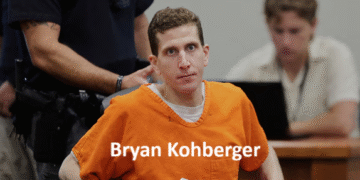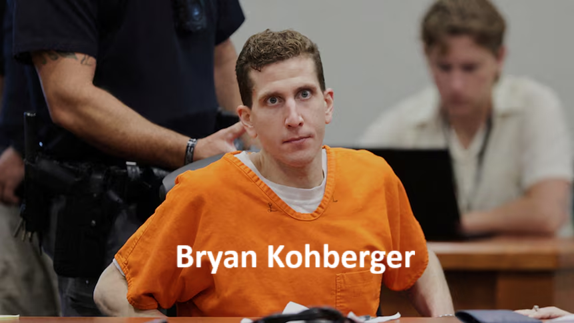Few criminal cases in recent years have drawn as much attention and debate as that of Bryan Kohberger, the man accused—and later convicted—of killing four University of Idaho students in late 2022. The story isn’t just about crime and punishment; it’s also about the disturbing intersection between intelligence, psychology, and human darkness. Who was Bryan Kohberger before his name became synonymous with one of the most chilling college-town tragedies in modern memory? And what does his story reveal about how society understands deviance, education, and motive?
This article breaks down his background, the investigation, the trial, and the questions that still linger long after the verdict.
The Background of Bryan Kohberger: From Student to Suspect
Before his arrest, Bryan Kohberger looked like an academic on a promising path. Born and raised in Pennsylvania, he came from a middle-class family that valued education and hard work. He attended Pleasant Valley High School and later went on to earn a bachelor’s degree in psychology and a master’s in criminal justice. By 2022, he had begun pursuing a Ph.D. in criminology at Washington State University in Pullman, Washington—a few miles from Moscow, Idaho, where the murders occurred.
What fascinated many observers is how someone immersed in the study of crime and criminal behavior could allegedly commit such an act himself. As a student, Bryan Kohberger was reportedly curious about criminal minds—interviewing former criminals for his research and exploring the psychological motives behind violent acts. Some classmates described him as “highly analytical” and “intense,” while others said he often dominated discussions, seeming fascinated by the logic of offenders more than their victims.
In retrospect, many people began re-examining his academic interests as potential warning signs. But hindsight is always 20/20. At the time, Bryan Kohberger seemed like any other ambitious grad student—quiet, focused, and consumed by his studies. There were no public indications that he would soon be accused of one of the most horrifying mass murders in recent American history.
The Night That Changed Everything

The crime that made Bryan Kohberger a household name occurred on November 13, 2022, when four University of Idaho students—Madison Mogen, Kaylee Goncalves, Xana Kernodle, and Ethan Chapin—were brutally stabbed to death inside their off-campus home in Moscow, Idaho. The small college town, known for its peaceful vibe, was thrust into national headlines overnight.
The attack appeared targeted yet strangely random. Two other roommates in the house survived, one of whom reported seeing a masked figure before locking herself in her room out of fear. For weeks, police struggled to identify a suspect. Social media exploded with speculation, amateur sleuthing, and conspiracy theories. The case gripped the nation—not just for its brutality, but because there seemed to be no clear motive.
When investigators finally named Bryan Kohberger as the suspect in December 2022, the reaction was disbelief. How could a Ph.D. student in criminology, of all people, be linked to such a gruesome act? For a time, the question hung over the nation like a cloud.
The Investigation: How Science and Persistence Solved the Case
The breakthrough came through DNA evidence. Detectives found a knife sheath at the crime scene that contained a single trace of DNA. That DNA didn’t match anyone in criminal databases, but investigators used genealogical tracing—similar to what’s used by ancestry testing—to connect it to the Bryan Kohberger family in Pennsylvania. Surveillance footage and cellphone data then placed Bryan Kohberger’s car near the victims’ house multiple times before and after the murders.
The investigative process was a masterclass in modern forensics. Analysts pieced together digital breadcrumbs—cell tower pings, vehicle movements, and security-camera sightings—to create a timeline. They discovered that Bryan Kohberger phone was turned off during the approximate window of the murders but reactivated later near the scene, a classic attempt to avoid digital tracking.
When police finally arrested him at his parents’ home in Pennsylvania on December 30, 2022, it ended nearly seven weeks of national tension. He was extradited to Idaho to face four counts of first-degree murder and one count of burglary. The case against him was largely circumstantial but compelling, blending physical evidence with behavioral profiling and cutting-edge technology.
Inside the Mind: The Psychology of Bryan Kohberger
The most unsettling aspect of the Bryan Kohberger case isn’t just the crime—it’s the psychology behind it. Here was someone who spent years studying criminal minds, seemingly fascinated by what drives people to kill. In one of his academic surveys, Bryan Kohberger reportedly asked former inmates to describe their thoughts and feelings during the commission of their crimes. It’s chilling to imagine that those questions may have mirrored thoughts he later acted upon.
Psychologists who have analyzed his background point to traits often associated with narcissism, social isolation, and a desire for control. Some reports suggested he was bullied in high school for being overweight and later underwent a transformation, losing weight and growing more confident—but perhaps also more detached. Friends described him as socially awkward, analytical, and at times intimidating.
Whether or not mental illness played a direct role remains debated. Bryan Kohberger later disclosed having certain diagnosed mental health conditions but never claimed they motivated his actions. What stands out most is how intelligence and darkness coexisted in him—a rare and terrifying mix that challenges assumptions about what “criminals” look like.
The Courtroom Drama: Plea, Sentence, and Reactions
After months of legal wrangling, Bryan Kohberger eventually pleaded guilty in 2025 to four counts of first-degree murder and one count of burglary, avoiding the death penalty in exchange for life in prison without parole. During the sentencing hearing, families of the victims delivered emotional impact statements, expressing grief, anger, and disbelief at the senselessness of the crime.
Bryan Kohberger himself declined to speak, showing little visible emotion. Some interpreted his silence as remorse; others saw it as cold detachment. The judge handed down four consecutive life sentences, ensuring he would never walk free again.
For many, the plea deal was bittersweet. On one hand, it spared the families a lengthy trial filled with painful details. On the other, it meant they would never fully hear the “why.” Even with all the forensic evidence and legal closure, the emotional puzzle remains incomplete.
The Broader Lessons: Crime, Academia, and Awareness
The Bryan Kohberger case raises deep questions about human nature and the thin line between understanding evil and succumbing to it. Can someone study crime so closely that they start identifying with the perpetrators? Does intellectual curiosity ever become obsession? These are uncomfortable but necessary questions, especially in academic fields like criminology.
For universities and communities, the case also served as a wake-up call about campus safety. Many colleges reviewed their emergency-response procedures and strengthened off-campus safety programs after the murders. Students became more alert, learning that even in quiet college towns, danger can appear in unexpected forms.
From a broader societal view, the case also highlighted the role of digital forensics in modern policing. Without the combination of genealogical DNA analysis, cellphone tracking, and surveillance footage, this crime might have gone unsolved for years. It’s a testament to how technology can deliver justice—but it also raises questions about privacy, surveillance, and how much access law enforcement should have to personal data.
What Remains: Reflection and the Quest for Meaning
Even after his conviction, Bryan Kohberger remains an enigma. No clear motive has ever been established. There was no personal connection between him and the victims, no history of violence, and no manifesto or confession explaining his intent. That absence of motive haunts both investigators and the public—it’s the kind of mystery that leaves an open wound.
The families of the four victims continue to honor their loved ones through scholarships, community events, and memorials. For them, the tragedy is both personal and public—a reminder that behind every headline, there are human stories of laughter, friendship, and dreams abruptly cut short.
Meanwhile, true-crime enthusiasts and psychologists continue to analyze the case, searching for clues that might explain the inexplicable. But perhaps the lesson is simpler: sometimes, evil doesn’t fit into tidy categories. Sometimes, people do terrible things not because of one reason, but because of a complex web of impulses and voids that even they may not understand.
Conclusion: A Case That Redefined Modern Crime Awareness
The story of Bryan Kohberger is more than a true-crime headline—it’s a mirror reflecting society’s fascination with criminal minds, the dangers of underestimating the intelligent, and the ongoing struggle to understand motive in senseless violence. He was not a cartoon villain, nor a misunderstood genius—just a man whose choices shattered lives and left an indelible scar on an entire community.
In the end, justice may have been served in the courtroom, but the emotional and psychological aftermath lingers. The case reminds us that monsters don’t always look like monsters—and that sometimes, they hide behind ordinary faces, advanced degrees, and polite conversations.

















































































